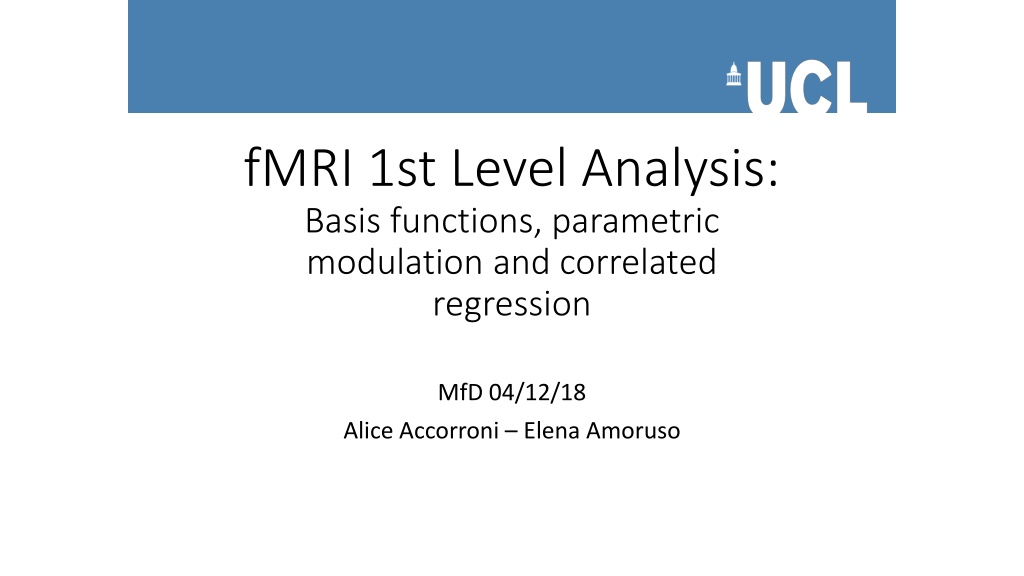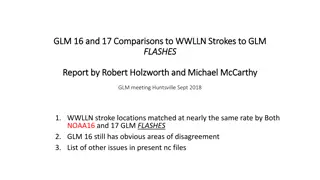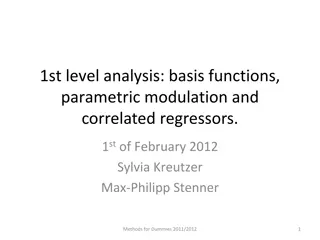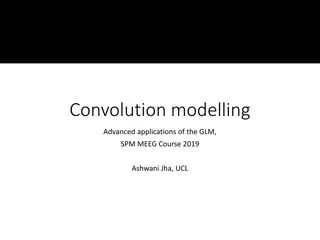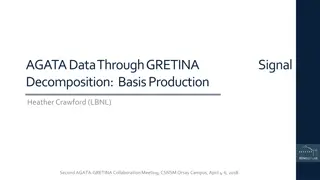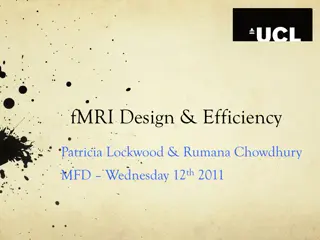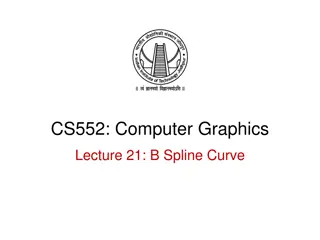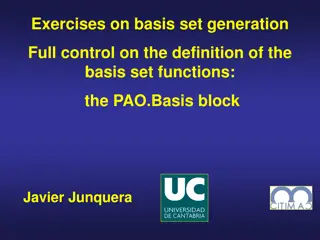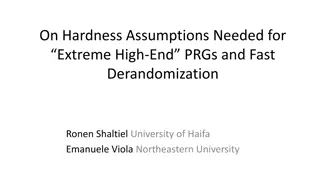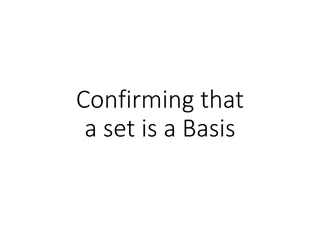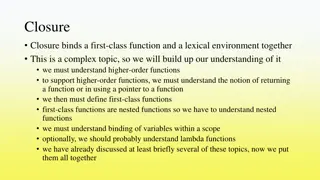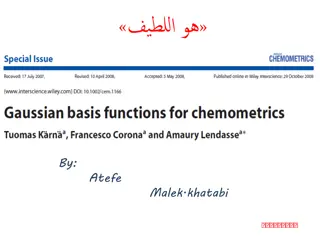Understanding fMRI 1st Level Analysis: Basis Functions and GLM Assumptions
Explore the exciting world of fMRI 1st level analysis focusing on basis functions, parametric modulation, correlated regression, GLM assumptions, group analysis, and more. Dive into brain region differences in BOLD signals with various stimuli and learn about temporal basis functions in neuroimaging research. Visualize the complexities of statistical parametric mapping, estimation, and group-level analyses in functional MRI studies.
Download Presentation

Please find below an Image/Link to download the presentation.
The content on the website is provided AS IS for your information and personal use only. It may not be sold, licensed, or shared on other websites without obtaining consent from the author. Download presentation by click this link. If you encounter any issues during the download, it is possible that the publisher has removed the file from their server.
E N D
Presentation Transcript
fMRI 1st Level Analysis: Basis functions, parametric modulation and correlated regression MfD 04/12/18 Alice Accorroni Elena Amoruso
Overview Preprocessing Data Analysis Statistical Parametric Map Design matrix Spatial filter Realignment General Linear Model Smoothing Statistical Inference RFT Normalisation p <0.05 Anatomical reference Parameter estimates
Estimation Estimation (1 (1st level) ) Group Analysis Group Analysis (2 (2nd level) ) st level nd level
The GLM and its assumptions Neural activity function is correct HRF is correct Linear time-invariant system
The GLM and its assumptions HRF is correct
The GLM and its assumptions Gamma functions 2 Gamma functions added
The GLM and its assumptions HRF is correct
The GLM and its assumptions Neural activity function is correct HRF is correct Linear time-invariant system Aguirre, Zarahnand D Esposito, 1998; Buckner, 2003; Wager, Hernandez, Jonides and Lindquist, 2007a;
Brain region differences in BOLD + Aversive Stimulus
Brain region differences in BOLD Sommerfield et al 2006
Temporal basis functions Canonical HRF HRF + derivatives Finite Impulse Response
Temporal basis functions Canonical HRF HRF + derivatives Finite Impulse Response
Correlated Regressors Correlated Regressors
Regression analysis Regression analysis 56 Regression analysis examines the 55 relation of a dependent variable Y to a 54 specified independent variables X: 53 52 LOUDNESS Y = a + bX 51 50 110 120 130 140 150 160 170 PITCH - if the model fits the data well: R2 is high (reflects the proportion of variance in Y explained by the regressor X) the corresponding p value will be low -
Multiple Regression Multiple Regression Multiple regression characterises the relationship between several independent variables (or regressors), X1, X2, X3 etc, and a single dependent variable, Y: Y = 1X1 + 2X2+ ..+ LXL + The X variables are combined linearly and each has its own regression coefficient (weight) s reflect the independent contribution of each regressor, X, to the value of the dependent variable, Y i.e. the proportion of the variance in Y accounted for by each regressor after all other regressors are accounted for
Multicollinearity Multicollinearity Multiple regression results are sometimes difficult to interpret: the overall p value of a fitted model is very low i.e. the model fits the data well but individual p values for the regressors are high i.e. none of the X variables has a significant impact on predicting Y. How is this possible? Caused when two (or more) regressors are highly correlated: problem known asmulticollinearity
Multicollinearity Multicollinearity Are correlated regressors a problem? No when you want to predict Y from X1 and X2 Because R2 and p will be correct Yes when you want assess impact of individual regressors Because individual p values can be misleading: a p value can be high, even though the variable is important
Multicollinearity Multicollinearity - - Example Example Question: how can the perceived clarity of a auditory stimulus be predicted from the loudness and frequency of that stimulus? Perception experiment in which subjects had to judge the clarity of an auditory stimulus. Model to be fit: Y = 1X1 + 2X2 + Y = judged clarity of stimulus X1 = loudness X2 = frequency
Regression analysis: multicollinearity example What happens when X1 (frequency) and X2 (loudness) are collinear, i.e., strongly correlated? 56 55 Correlation loudness & frequency : 0.945 (p<0.000) 54 53 52 High loudness values correspond to high frequency values LOUDNESS 51 50 110 120 130 140 150 160 170 FREQUENCY PITCH
Regression analysis: multicollinearity example Contribution of individual predictors (simple regression): X1 (loudness) is entered as sole predictor: Y = 0.859X1 + 24.41 R2 = 0.74 (74% explained variance in Y) p < 0.000 X2 (frequency) entered as sole predictor: Y = 0.824X1 + 26.94 R2 = 0.68 (68% explained variance in Y) p < 0.000
Collinear regressors X1 and X2 entered together (multiple regression): Resulting model: Y = 0.756X1 + 0.551X2 + 26.94 R2 = 0.74 (74% explained variance in Y) p < 0.000 Individual regressors: X1 (loudness): X2 (frequency): R2 = 0.555, p < 0.594 R2 = 0.850 , p < 0.000
GLM and Correlated Regressors GLM and Correlated Regressors The General Linear Model can be seen as an extension of multiple regression (or multiple regression is just a simple form of the General Linear Model): Multiple Regression only looks at one Y variable GLM allows you to analyse several Y variables in a linear combination (time series in voxel) ANOVA, t-test, F-test, etc. are also forms of the GLM
General Linear Model and fMRI Y= X. + Observed data Y is the BOLD signal at various time points at a single voxel Design matrix Parameters Define the contribution of each component of the design matrix to the value of Y Error/residual Difference between the observed data, Y, and that predicted by the model, X . Several components which explain the observed data Y: -Different stimuli -Movement regressors
fMRI Collinearity fMRI Collinearity If the regressors are linearly dependent the results of the GLM are not easy to interpret Experiment: Which areas of the brain are active in visual movement processing? Subjects press a button when a shape on the screen suddenly moves Model to be fit: Y = 1X1 + 2X2 + Y = BOLD response X1 = visual component X2 = motor response
How do I deal with it? Ortogonalization Ortogonalization y = 1X1 + 2*X2 * y y 1 = 1.5 2 * = 1 x x2 2 x x2 2* * x x1 1
How do I deal with it? Experimental Design Experimental Design Carefullydesignyour experiment! When sequential scheme of predictors (stimulus response) is inevitable: inject jittered delay (see B) use a probabilistic R1-R2 sequence (see C)) Orthogonalizing might lead to self- fulfilling prophecies (MRC CBU Cambridge, http://imaging.mrc-cbu.cam.ac.uk/imaging/DesignEfficiency)
Types of experimental design 1. Categorical - comparing the activity between stimulus types 2. Factorial - combining two or more factors within a task and looking at the effect of one factor on the response to other factor 3. Parametric - exploring systematic changes in BOLD signal according to some performance attributes of the task (difficulty levels, increasing sensory input, drug doses, etc)
Parametric Design Complex stimuli with a number of stimulus dimensions can be modelled by a set of parametric modulators tied to the presentation of each stimulus. This means that: Can look at the contribution of each stimulus dimension independently Can test predictions about the direction and scaling of BOLD responses due to these different dimensions (e.g., linear or non linear activation).
Parametric Modulation Example: Very simple motor task - Subject presses a button then rests. Repeats this four times, with an increasing level of force. Hypothesis: We will see a linear increase in activation in motor cortex as the force increases Model: Parametric Contrast: 0 1 0 Linear effect of force Time (scans) 5 4 10 3 2 15 1 0 20 -1 -2 25 -3 -4 0 5 10 15 20 25 30 35 30 0.5 1 1.5 2 2.5 3 3.5 Regressors: press force mean
Parametric Modulation Example: Very simple motor task - Subject presses a button then rests. Repeats this four times, with an increasing level of force. Hypothesis: We will see a linear increase in activation in motor cortex as the force increases Model: Parametric Quadratic effect of force Contrast: 0 0 1 0 Time (scans) 5 10 9 10 8 7 6 15 5 4 20 3 2 1 25 0 -1 0 5 10 15 20 25 30 35 30 0.5 1 1.5 2 2.5 3 3.5 4 4.5 Time (scans) Regressors: press force (force)2 mean
Thanks to Rik Henson s slides: www.mrc-cbu.cam.ac.uk/Imaging/Common/rikSPM-GLM.ppt Previous years presenters slides Guillaume Flandin
